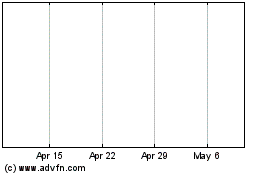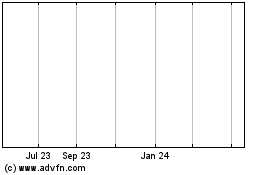CBRE Buys Stake in $1.5 Billion Retail Portfolio
November 22 2016 - 8:30AM
Dow Jones News
CBRE Global Investment Partners said it has invested about $450
million for a 45% stake in a portfolio of West Coast retail
property, in a bid to tap into rising consumer spending in a region
driven by technology-sector growth.
Privately held real-estate investment company Merlone Geier
Partners controls the portfolio of 55 shopping centers and other
assets totaling almost 7 million square feet, and will remain the
majority owner and operator.
CBRE Global Investment Partners will also assume its share of
debt for the $1.5 billion portfolio. It is expected to announce the
deal on Tuesday.
The properties are anchored largely by grocers and other
retailers of staples, making them less sensitive to changes in the
economy.
The West Coast retail property market is light on supply, and
strong consumer spending there should translate to higher rents,
said Jeremy Plumber, chief executive officer of CBRE Global
Investment Partners.
The portfolio's occupancy rate stands at only about 85% because
some of the assets are being redeveloped, said Paul Sisson, head of
Americas at CBRE Global investment Partners. Once the properties
are completed, occupancy should reach 94% to 95%, he said. The
strip centers have anchor tenants such as grocery giants Safeway,
Albertsons and Trader Joe's, where consumers frequent in good times
and bad.
The deal comes a week after Regency Centers Corp. said it
planned to acquire Equity One Inc. for about $5 billion in an
all-stock transaction that will create one of the nation's largest
shopping-center landlords. The two real-estate investment trusts
have large strip center portfolios around the country.
Hap Stein, chief executive of Regency Centers, which is based in
Jacksonville, Fla., said the two portfolios are complementary and
the deal would result in economies of scale.
While properties in areas with high population density and high
household incomes are still desirable, overall deal activity in
retail real estate this year has been muted.
During the first 10 months of the year, retail-property
transaction volume was $62.9 billion, down 16% from the same period
a year earlier, according to data tracker Real Capital Analytics.
There was more activity in residential, office and hotel
properties, according to the company.
The rise of online shopping, along with retailer bankruptcies
and overbuilding a decade ago, have driven up vacancies and forced
retail property owners and real-estate investment trusts to
consolidate and unload underperforming centers. Kmart, which had a
huge presence in strip centers, has closed hundreds of stores over
the years.
"The headwind is obviously e-commerce, which is
disproportionately affecting retail real estate," said Mr.
Plumber.
While some landlords are struggling to re-lease the space,
others in better locations have been able to redevelop vacated
space and bring in new tenants.
The two best categories these days are grade-A malls owned by
the largest REITs, which remain strong because their space is still
coveted by retailers, and strip centers anchored by grocery stores,
which are more impervious to changing shopping habits.
Prices in better-located strip centers are commanding prices
roughly 23% higher than at the peak of the last market cycle, said
Ryan McCullough, an economist at CoStar Group. Weaker centers in
suburban locations, by contrast, have seen prices fall by about 50%
from their peak.
"It's a street corner game," said Mr. McCullough.
Smaller, single-tenant properties with drugstores or
quick-service restaurants also have grown as a share of retail
property sales.
"Grocery-anchored retail is considered safe by most investors in
that the tenants still have clients even in an economic downturn,"
said Jim Costello, senior vice president at Real Capital Analytics.
"Everyone has to eat."
Write to Esther Fung at esther.fung@wsj.com
(END) Dow Jones Newswires
November 22, 2016 08:15 ET (13:15 GMT)
Copyright (c) 2016 Dow Jones & Company, Inc.
CBRE Group, Inc. (NASDAQ:CBRE)
Historical Stock Chart
From Mar 2024 to Apr 2024

CBRE Group, Inc. (NASDAQ:CBRE)
Historical Stock Chart
From Apr 2023 to Apr 2024
